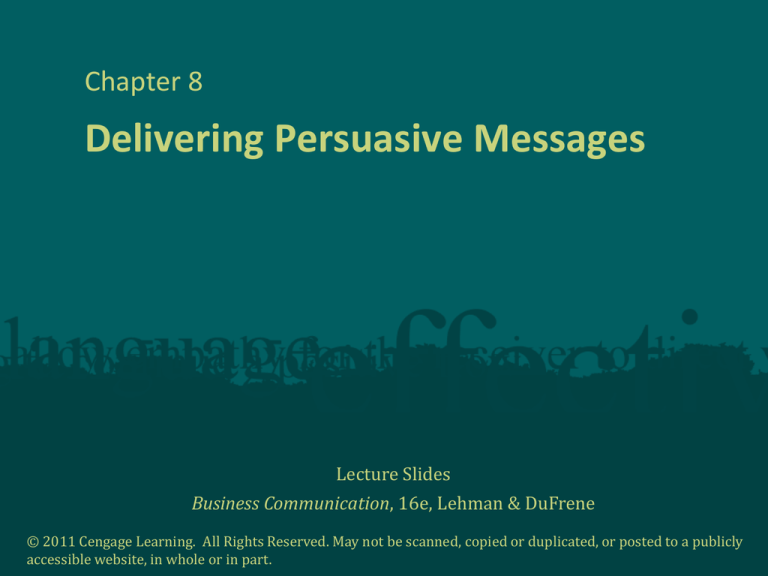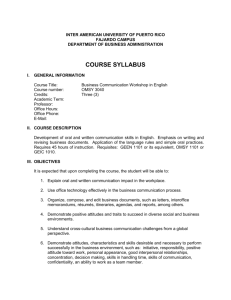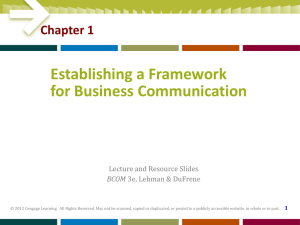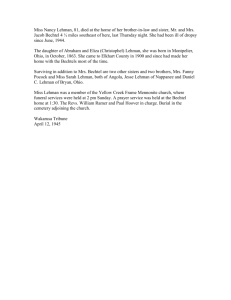
Chapter 8
Delivering Persuasive Messages
Lecture Slides
Business Communication, 16e, Lehman & DuFrene
© 2011 Cengage Learning. All Rights Reserved. May not be scanned, copied or duplicated, or posted to a publicly
accessible website, in whole or in part.
Before Composing a Persuasive
Message, Know . . .
Your product, service, or idea
Your audience
The desired action you wish your
audience to take
Chapter 8, Business Communication, 16e, Lehman & DuFrene
© 2011
Cengage Learning
How To Know Your Product
• Read all the available ________
literature
• Use the product or ______
watch others use it
• Compare
________ the product, service, or idea
with others
• Conduct tests or experiments
___________
• Talk to people who really ____
use the
product
Chapter 8, Business Communication, 16e, Lehman & DuFrene
© 2011
Cengage Learning
Knowing Your Receiver
• Identify basic demographics
– Age, gender, educational background, income
level, race…
• Know receiver’s wants and needs
• Consider how you can meet receiver
needs based on Maslow’s hierarchy
Chapter 8, Business Communication, 16e, Lehman & DuFrene
© 2011
Cengage Learning
Inductive Outline Used
for Persuasive Messages
Chapter 8, Business Communication, 16e, Lehman & DuFrene
© 2011
Cengage Learning
Elements of Ethical Persuasion
• Clear definition of offered product or
service
• Scientific evidence for product claims
• Context for comparative statements
• Audience sensitivity for ideas that are
objectionable or offensive
Chapter 8, Business Communication, 16e, Lehman & DuFrene
© 2011
Cengage Learning
Types of Persuasive Messages
Unsolicited sale
messages
Claim messages
Favor requests
Information
requests (survey
messages)
Chapter 8, Business Communication, 16e, Lehman & DuFrene
© 2011
Cengage Learning
Your Turn
Which question is most important to answer
before composing your persuasive message?
1.
2.
3.
4.
What will the product do for the
receiver?
What are its superior features
(receiver benefit)?
How is it different from the
competition?
What is the cost to the receiver?
Chapter 8, Business Communication, 16e, Lehman & DuFrene
© 2011
Cengage Learning
Apply Sound Writing Principles
• Keep paragraphs _____
short
• Use ________
_____ verbs, and
concrete nouns, active
specific language
_______
• Put the receiver in the ________
spotlight
• Stress a central ______
selling _____
point
Chapter 8, Business Communication, 16e, Lehman & DuFrene
© 2011
Cengage Learning
Gaining Attention in Sales Messages
Personal
experience
Solution to a
problem
Startling
statement
“What if”
opening
Story/quote/
question
Split sentence
Analogy
Chapter 8, Business Communication, 16e, Lehman & DuFrene
© 2011
Cengage Learning
Introducing the Product,
Service, or Idea
• Be cohesive
– Make attention-getter lead naturally to introduction
• Be action-oriented
– Place the product in receivers’ hands and allow them
to use it
• Stress a central selling point
– Link attention-getter to discussion of distinctive
feature
Chapter 8, Business Communication, 16e, Lehman & DuFrene
© 2011
Cengage Learning
Presenting and Interpreting
Factual Evidence
• Do not just say it, show it
– Present data to back up the central selling point
• Compare a new product with something
familiar
• Be objective, avoiding exaggerations
and subjective claims
Chapter 8, Business Communication, 16e, Lehman & DuFrene
© 2011
Cengage Learning
Ways to Convince Customers
Testimonials
• Tell what others have said about
your product
Guarantees
or free trials
• Provide recourse if purchase is not
satisfactory
Samples
• Allow customers to sample product
before buying
Chapter 8, Business Communication, 16e, Lehman & DuFrene
© 2011
Cengage Learning
Subordinating the Price
• Create a desire
_____ for the product first
• Use ______
figures to show how the price saves
money
• State the price in _____
small ____
units
• Invite comparisons
___________with like products
subordinate
• Mention price in a ___________clause
combined with the central selling point
Chapter 8, Business Communication, 16e, Lehman & DuFrene
© 2011
Cengage Learning
Motivating Action
• Make the action clear and simple to
complete
• Restate the reward for action; relate to
central selling point
• Provide incentive for quick action
• Ask confidently for action
Chapter 8, Business Communication, 16e, Lehman & DuFrene
© 2011
Cengage Learning







